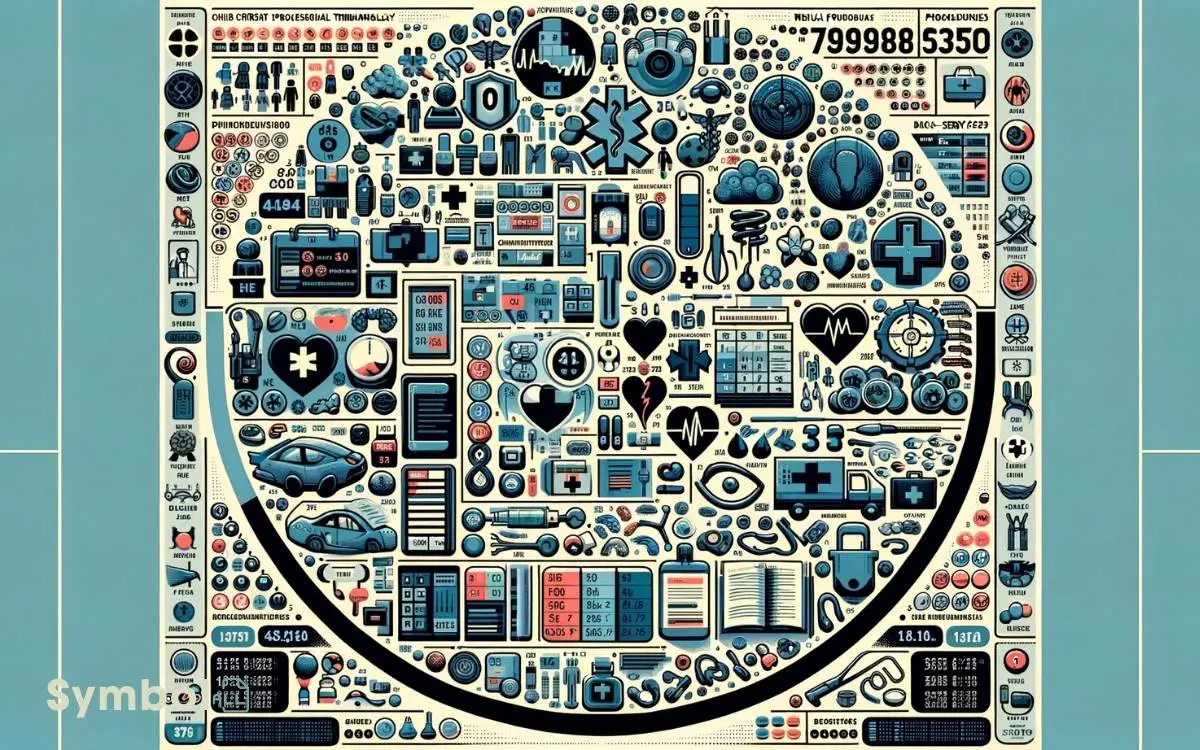How Many Symbols Are Used in the Cpt Manual? Explains!
In the CPT manual, you’ll encounter various symbols designed to guide accurate medical billing and coding. These include a triangle for revised code descriptions, bullet points for specific usage rules, and a circle for updated codes.
Plus signs highlight procedures that accompany primary services, while minus signs indicate exceptions. The lightning bolt symbolizes FDA-approved procedures, and the bullseye represents modifier-free reporting.
A star denotes advanced technology procedures, and number signs uniquely identify each process.
Altogether, these symbols guarantee you code precisely and comply with billing standards, paving the way for smoother billing processes and patient care. Explore further to grasp their full significance.

Key Takeaways
Complete Guide to CPT Manual Symbols and Their Meanings
| Symbol | Description |
|---|---|
| ⚫ Bullet | Identifies new procedures and services |
| ▲ Triangle | Indicates the code description has been revised |
| + Plus Sign | Represents add-on codes for procedures performed in addition |
| 🔽 Triangle pointing down | Represents re-sequenced codes |
| ⃰ Asterisk | Designates codes that include moderate (conscious) sedation |
| 🚫 Lightning Bolt | Indicates a code that is not used with Medicare patients |
| 🟊 Bullseye | Used for codes related to telemedicine services |
| # Pound | Used for re-sequenced codes, similar to the triangle pointing down |
| ◊ Diamond | Indicates a service that is covered by the Medicare limited coverage policy |
| ℞ Prescription Symbol | Identifies codes that require a prescription to be dispensed |
Symbol Overview
In the CPT Manual, a variety of symbols are used to guide users through intricate coding instructions and modifications, each crafted with a specific purpose in mind. You’ll come across symbols that indicate new procedures, revised descriptions, and deletions.
There’s also a symbol to identify codes that have been resequenced out of numerical order, ensuring you’re informed when codes don’t follow the expected sequence.
Additionally, modifiers are represented by symbols, emphasizing alterations that impact how a service or procedure’s code should be interpreted.
While exploring the manual, you’ll find these symbols vital for accurate coding, ensuring compliance and proper billing. They serve as a reference point for understanding the precise meaning of each code, minimizing errors in documentation. Additionally, it’s essential to recognize how visual elements, such as those aligned with ISO 7010 signage standards, can enhance clarity in communication. By integrating these standards, you can further streamline processes and maintain consistency across various applications.
Familiarizing yourself with each symbol’s meaning is critical, as they’re fundamental to grasping the subtleties of coding language and applying it correctly in medical billing processes.
Triangle Symbol Meaning
You’ll notice the triangle symbol next to certain codes in the CPT manual, a signifier of significant importance.
This symbol points out that a code’s description has been revised, signaling you to pay extra attention.
Understanding its usage is key to accurately interpreting procedural changes and ensuring precise billing and documentation.
Triangle Symbol Significance
A triangle symbol next to a code in the CPT manual signifies that the description of the procedure or service has undergone a recent revision. It’s important for you to stay abreast of these changes to guarantee accurate billing and compliance with insurance requirements.
The triangle symbol acts as a prompt, urging you to pay close attention to the altered details of the procedure.
This could range from a minor tweak in how the procedure is described to a significant change in the procedure itself. Understanding the significance of this symbol helps you maintain the integrity of your coding practices.
It serves as a reminder to review the specifics of the revised codes, ensuring that your documentation and billing are up-to-date. This vigilance supports the accuracy and efficiency of healthcare administration.
Revisions Indicated
Understanding the triangle symbol’s meaning is crucial, as it indicates that a CPT code’s description has been revised. When you see this symbol, it’s a clear sign to pay attention to the changes, as they can impact how you report and bill for procedures.
This revision can range from minor description alterations to significant changes in procedure scope. Familiarizing yourself with these revisions guarantees accurate and up-to-date billing practices.
This concise understanding allows you to navigate the CPT manual more efficiently, ensuring that you’re always working with the most current information.
Interpreting Triangle Usage
Delving into the usage of the triangle symbol provides essential insights into the nuanced changes within the CPT code descriptions.
You’ll find this symbol preceding a code, indicating a modification or revision has been made to the code’s description, but not its core intent or scope.
It’s paramount you pay attention to these markers, as overlooking them could lead to misinterpretation of a procedure’s details or billing inaccuracies.
Understanding the triangle’s significance guarantees that you’re up-to-date with the latest procedural definitions and guidelines.
This knowledge is vital, especially when documenting procedures or submitting claims, as it directly impacts coding accuracy and compliance. So, always keep an eye out for the triangle to stay informed about any updates within the CPT manual.
Bullet Point Usage
You’ll find that bullet points in the CPT manual serve as essential indicators, guiding you through new or revised procedures and services.
They’re pivotal in ensuring you don’t miss out on key updates, but it’s easy to overlook their significance without understanding their definitions and the common pitfalls in their use.
Bullet Point Definitions
Often, bullet points in the CPT Manual indicate specific usage rules and exceptions critical for accurate coding. You’ll find them marking codes that have special instructions or unique considerations.
For example, a bullet point may signify that a code is new or has been revised. It’s your cue to pay extra attention.
These markers guide you in selecting the most precise code for a procedure, ensuring the documentation reflects the service provided accurately.
Understanding each bullet point’s definition helps you navigate the complexities of medical billing and coding. They’re not merely symbols; they’re essential tools for precise communication between healthcare providers and insurers.
Grasping their meanings simplifies the coding process, leading to more effective and efficient billing practices.
Importance in CPT Manual
Understanding bullet point usage in the CPT Manual greatly enhances your ability to select the precise code for any given medical procedure.
These symbols serve as critical guides, directing you toward codes that are new, revised, or have specific considerations. They’re not just markers; they represent essential information that could impact billing and, consequently, reimbursement.
For instance, a bullet point might indicate a new procedure code, alerting you to the evolution of medical practices and ensuring your coding is up-to-date. Grasping the significance of these symbols allows for more accurate documentation, which is pivotal in medical billing and coding.
It’s about more than just following rules; it’s about ensuring patients’ services are correctly recorded and healthcare providers are fairly compensated.
Common Formatting Errors
When utilizing the CPT manual, it’s important to remember that a common formatting error involves incorrect bullet point usage, which can lead to significant misunderstandings in code selection.
Bullet points should clearly separate distinct elements, ensuring that each item stands out for easy reference.
| Proper Usage | Common Mistakes | Consequences |
|---|---|---|
| Clear spacing | Overcrowded text | Confusion |
| Consistent style | Mixed styles | Misinterpretation |
| Concise wording | Excessive details | Inefficiency |
Using bullet points correctly enhances the readability and helps you quickly identify the key components necessary for accurate code selection. It’s essential to maintain uniformity in spacing, style, and wording.
This meticulous attention to detail will not only streamline your coding process but also minimize the risk of errors, ensuring precise documentation and billing.
Circle Symbol Interpretation
The circle symbol in the CPT manual signifies that the code has been revised, highlighting essential changes you need to be aware of. When you encounter this symbol, it’s important to pause and examine the modifications carefully.
These revisions can range from minor adjustments in the description to more significant changes that could affect billing and documentation practices.
Understanding these updates ensures that you’re coding procedures accurately, which is important for compliance and reimbursement purposes.
The CPT manual’s use of symbols, like the circle, is designed to streamline the process of identifying these important changes, making it easier for you to stay current with the evolving landscape of medical coding.
Always consult the latest manual edition to ensure you’re working with the most up-to-date information.
Plus and Minus Signs
In the CPT manual, plus and minus signs play important roles, indicating when a procedure is add-on or when specific guidelines or limitations apply, respectively.
Understanding these symbols is vital:
- Plus Sign (+): Marks procedures that are always performed in addition to the primary service. They can’t stand alone and signal extra steps or complexity.
- Minus Sign (-): While not a standalone symbol in the CPT, its concept implies restrictions or exceptions to a procedure, often detailed in the guidelines.
- Usage Context: The location and context of these symbols provide insight into billing and documentation requirements.
- Impact on Billing: Correct interpretation ensures accurate billing, preventing undercharging or claims denial for inappropriate coding.
Grasping these symbols’ significance aids in precise coding, essential for efficient healthcare billing and reimbursement processes.
Lightning Bolt Significance
Understanding the plus and minus signs establishes a solid foundation, yet it’s equally important to know the role of the lightning bolt symbol in the CPT manual for thorough coding insights.
This symbol indicates that a procedure or service is FDA-approved under specific conditions, often related to new technologies or devices not yet widely available.
It’s your cue that while the procedure has received FDA backing, it may still be under scrutiny or limited in use. As a coder, recognizing the lightning bolt helps you navigate billing complexities associated with these procedures, ensuring accurate claims processing.
Grasping its significance guarantees you’re up-to-date with evolving medical technologies and their coding implications, essential for maintaining billing accuracy and compliance.
Bullseye Symbol Explanation
Delving into the complexities of the CPT manual, you’ll notice the bullseye symbol, which signifies that a procedure or service is available for reporting with no modifier under certain circumstances, a detail important for precise billing.
To grasp its significance, consider these points:
- Modifier-Free Reporting: Indicates specific cases where modifiers aren’t required for accurate billing.
- Situational Use: Not all procedures allow this, making it critical to recognize when it applies.
- Billing Precision: Helps guarantee claims are submitted correctly the first time, reducing denials.
- Documentation Importance: Proper documentation is vital to support the use of codes associated with this symbol.
Understanding the bullseye symbol enhances your coding accuracy, a cornerstone for effective medical billing.
Star Icon Function
Shifting focus to another important symbol, let’s explore the star icon’s role in the CPT manual. The star signifies advanced technology procedures subject to specific coding rules.
When you see this icon next to a code, it indicates that the procedure involves new or emerging technology.
This designation is important because it helps you understand that these procedures might have different billing and documentation requirements compared to standard procedures.
It’s imperative to pay close attention to these codes because they often reflect the latest advancements in medical technology and treatment.
Recognizing the star icon guarantees you’re coding these procedures accurately, which is crucial for proper billing and reimbursement. Understanding its significance helps maintain compliance and supports the accurate representation of medical services rendered.
Number Significance
Exploring the significance of numbers in the CPT manual reveals their vital role in accurately categorizing and coding various medical procedures.
Each number you encounter isn’t just a digit; it’s a key part of a sophisticated system designed to ensure clarity and consistency across the healthcare industry.
Let’s dive into what makes these numbers so crucial:
- Identification: Numbers uniquely identify each procedure, eliminating ambiguity.
- Classification: They group similar procedures, aiding in quick reference.
- Complexity Level: Certain number ranges signify the complexity and resources required.
- Billing: They’re essential for accurate billing, ensuring healthcare providers are compensated correctly.
Understanding these aspects helps you grasp how fundamental numbers are in the CPT manual, impacting everything from patient care to billing practices.
Conclusion
In wrapping up, you’ve now navigated the complexity of the CPT manual, enriched by a myriad of symbols, each with its distinct purpose. From the guiding triangle to the informative star icon, these symbols streamline coding, ensuring precision in medical billing.
Notably, the manual uses over 10,000 codes, each potentially modified by symbols, highlighting the manual’s intricate design to cater to diverse medical scenarios.
This precise system underscores the importance of detail in medical documentation, ensuring every patient’s care is accurately represented and billed.





